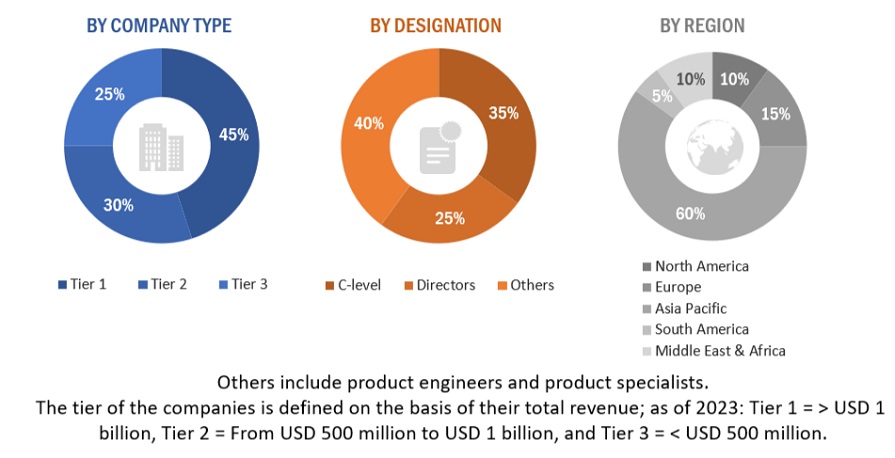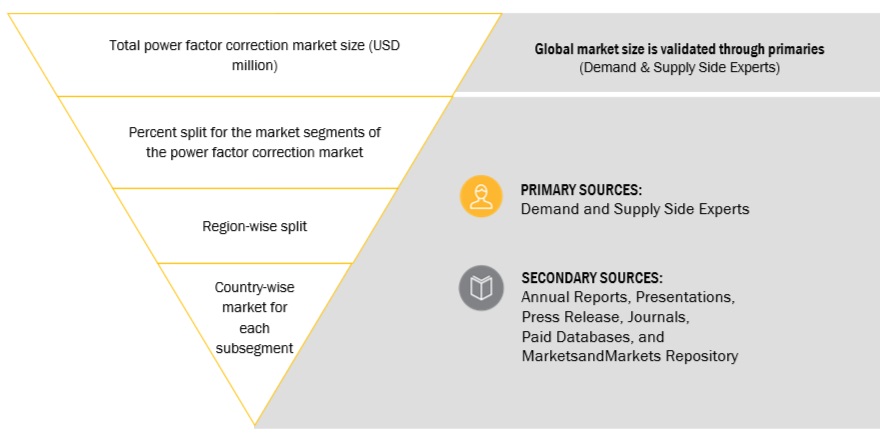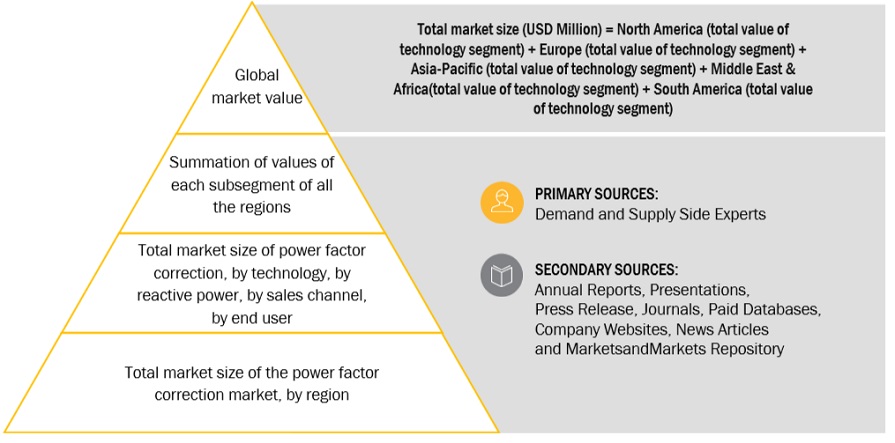The study involved major activities in estimating the current size of the power factor correction market. Exhaustive secondary research was done to collect information on the peer and parent markets. The next step was to validate these findings, assumptions, and sizing with industry experts across the value chain through primary research. Both top-down and bottom-up approaches were employed to estimate the complete market size. Thereafter, market breakdown and data triangulation were used to estimate the market size of the segments and subsegments.
Secondary Research
This research study on the power factor correction market involved the use of extensive secondary sources, directories, and databases, such as Hoovers, Bloomberg, Businessweek, Factiva, International Energy Agency, and United States Energy Association, to identify and collect information useful for a technical, market-oriented, and commercial study of the global power factor correction market. The secondary sources referred to for this research study included annual reports, press releases, investor presentations of companies, white papers, certified publications, articles from recognized authors, and various companies and association databases. Secondary research was conducted to obtain key information about the industry’s supply chain, the market’s monetary chain, the total pool of key players, market classification and segmentation according to industry trends to the bottom-most level, country-level markets, and key developments from the market- and technology-oriented perspectives.
Primary Research
The power factor correction market comprises several stakeholders such as power factor correction manufacturers, suppliers and distributors of power factor correction in the supply chain. The demand side of this market is characterized by the adoption of power factor correction across various end use industries. The supply side is characterized by products offered by various power factor correction manufacturers and mergers & acquisitions among big players. Various primary sources from both the supply and demand sides of the market were interviewed to obtain qualitative and quantitative information.
Following is the breakdown of primary respondents:

To know about the assumptions considered for the study, download the pdf brochure
Market Size Estimation
Both top-down and bottom-up approaches were used to estimate and validate the total size of the power factor correction market. These methods were also used extensively to estimate the size of various subsegments in the market. The research methodology used to estimate the market size includes the following:
-
The key players in the industry and market have been identified through extensive secondary research, and their market share in the respective regions has been determined through both secondary and primary research.
-
The industry’s supply chain and market size, in terms of value, have been determined through primary and secondary research processes.
-
All percentage shares, splits, and breakdowns have been determined using secondary sources and verified through primaries.
Global Power factor correction Market Size: Top-down Approach

To know about the assumptions considered for the study, Request for Free Sample Report
Global Power factor correction Market Size: Bottom-Up Approach

Data Triangulation
After arriving at the overall market size from the estimation process explained above, the total market has been split into several segments and subsegments. The complete market engineering process is done to arrive at the exact statistics for all the segments and subsegments, also data triangulation and market breakdown processes have been employed, wherever applicable. The data has been triangulated by examining various factors and trends from both the demand- and supply sides. Along with this, the market has been validated through both the top-down and bottom-up approaches.
Market Definition
The power factor correction refers to the utilization of capacitor banks that are designed to improve the efficiency of an electrical power system by compensating for the lagging power factor caused by inductive loads such as motors, transformers, and other inductive devices. Capacitor banks are strategically installed to supply reactive power (KVARs) to the system, which reduces the amount of reactive power that needs to be supplied by the utility, thereby improving the power factor.
Key Stakeholders
-
Suppliers of raw materials
-
Technology investors
-
Manufacturers of wide variety of power factor correction systems
-
Integrator and service provider of power factor correction systems
-
Component providers
-
System integrators
-
Consulting service providers
-
Distributors, resellers, and traders
-
Organizations, forums, alliances, and associations
-
State and national regulatory authorities
-
Venture capital firms
-
Financial organizations
-
Healthcare organizations
-
Research Institutes and organizations
-
Energy associations
-
Environment associations
-
Energy efficiency consultants
-
State and national regulatory authorities
Objectives of the Study
-
To describe and forecast the power factor correction market in terms of value and volume based on reactive power, type, sales channel, application, and region
-
To provide detailed information about the key factors such as drivers, restraints, opportunities, and challenges influencing the growth of the power factor correction market
-
To strategically analyze the subsegments with respect to individual growth trends, prospects, and contributions of each segment to the overall market size
-
To forecast the market size for five key regions: North America, Europe, Asia Pacific, Middle East & Africa, and South America, along with their key countries
-
To strategically analyze micromarkets1 with respect to individual growth trends, prospects, and contributions to the total market
-
To study the complete supply chain and allied industry segments and perform a supply chain analysis of the power factor correction market’ landscape
-
To study market trends, patent analysis, trade analysis, tariff and regulatory landscape, Porter’s five forces analysis, ecosystem mapping, technologies, investment and funding scenario, key stakeholders & buying criteria, case studies pertaining to off power factor correction market
-
To analyze the opportunities for various stakeholders by identifying the high-growth segments of the power factor correction market
-
To profile the key players and comprehensively analyze their market positions in terms of ranking and core competencies2, along with detailing the competitive landscape for the market leaders
-
To analyze competitive developments, such as contracts, collaborations, expansions, product launches, investments, and acquisitions, in the power factor correction market
Available Customizations:
With the given market data, MarketsandMarkets offers customizations as per the client’s specific needs. The following customization options are available for this report:
Geographic Analysis
-
Further breakdown of region or country-specific analysis
Company Information
-
Detailed analyses and profiling of additional market players (up to 5)



Growth opportunities and latent adjacency in Power Factor Correction Market